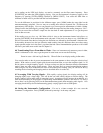9
and carrier buttons are only active in the SSB channel modes. The tone button is only useful for phone line
analysis and won’t be used or discussed in this document.
4.4 Status Group - This small status sub panel on the top far right indicates if the instrument is receiving
or sending data to a remote computer and weather it’s under local or remote control. If the remote
annunciator is on, press [LOCAL]. For our use it should always be in local front panel control mode.
4.5 Measurement Mode Group - On the lower LH side is the measurement mode sub panel that’s used
for selection of how level a measurement will be made by the instrument. All versions have the selective
mode buttons, but only the A and B versions have the specialized SSB channel modes for performing many
SSB channel measurements. The only useful SSB modes I have found a use for are noise/demod, carrier,
and impulse modes. With the shift key light off, press the selective [LO DIST] key to select the maximum
dynamic measurement range for the instrument.
4.6 Termination Group – Never put more than +27dbm or .5 watts total power into the input 50
ohm or 75 ohm connector of a HP3586 when using the internal termination. Never put more than
+42 volts total AC + DC into an unterminated connector.
The termination sub panel is also located on the lower LH of the control panel. This panel is used to select
the input termination for an input signal. The 50 or 75 ohm unbalanced input on the LH side of the panel is
the only ones useful for radio work and used in the examples of this document. The others use non-
standard RF circuit impedances and are for telephone applications. See Chapter 3 for a complete
description on how to connect to the unbalanced low impedance input.
For the measurements we’ll be doing in the following chapter, press the [100K 50pf] button on an A or B
versions. On the C version press the [50 ohm] button and the unlabeled shift key to the right of the 75 ohm
key to remove its 50 ohm load. If you’re not connected in parallel with a terminated load like a radio
receiver, and need a termination such as when being directly connected to an antenna feed line, turn off the
shift key’s light on the C version to provide a load. For unterminated 50 ohm loads using the A or B
version you will need to provide an external 50 ohm termination. In Appendix C is a schematic for a
termination box with a blocking capacitor that I use with my HP3586B.
4.7 Entry Group - On the lower center of the front panel is located the entry sub panel. This sub panel
is used for entry of frequencies, data offsets, frequency tuning steps, full scale measurement values, and
transferring frequency and offset values to their respective registers by using its keyboard buttons.
One very important key is the measurement continue key, [MEAS CONT]. During many data entries that
use one of the LED displays this key’s red light will turn on or flash indicating the instrument’s
measurement process has been interrupted. Anytime you see this button’s light and want to return to the
measurement mode press this key to continue measuring. You can also press it to cancel a mistaken
partially keyboard entry.
Another useful feature of the HP3586 is its ability to store its configuration settings for future use in
making similar future measurements. To do this you can press [STORE] on the entry sub panel followed
by any number from 1 to 9 on the keyboard. This will store the present configuration of the instrument in
the memory location of the number pressed for future recall and to save setup time. To recall the
configuration press [RECALL] followed by the register number to rapidly configure the instrument to a
previously stored configuration. To return to the default power up configuration, press [RECALL] then
enter 0. These configurations will be stored after the front panel power button is off and the instrument is
in standby as long is AC power is connected to the instrument or its internal battery is charged.
Unfortunately many surplus HP3586’s have dead batteries or their batteries removed and will loose their
stored configurations when disconnected from AC power.


















